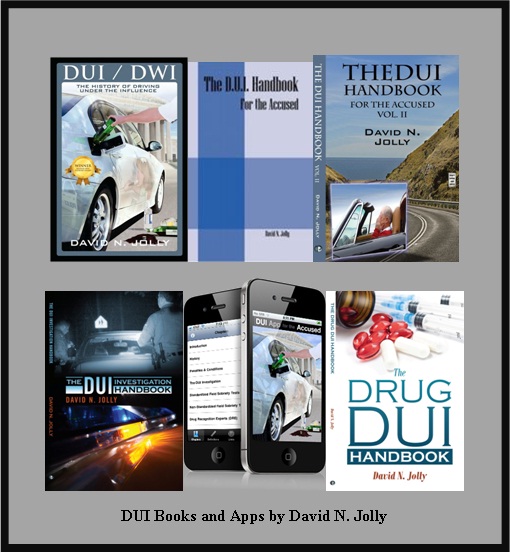The field sobriety tests are a critical component to the DUI arrest and investigation process. The following information is an excerpt from the upcoming book, "The DUI Handbook for the Accused, Vol. II." This valuable book is due out in March, 2011 and is the most thorough and complete DUI resource for the accused in the United States. Please check back for an announcment as to its availability. It will be avialble in over 100 online bookstores in including amazon.com and barnesandnoble.com.
Horizontal Gaze Nystagmus (HGN)
The technical definition of nystagmus is that is the rhythmic back and forth oscillation of the eyeball that occurs when there is a disturbance of the vestibular (inner ear) system or the oculomotor control of the eye. There are two major types of eye movements: pendular and jerk. Pendular nystagmus is where the oscillation speed is the same in both directions. Jerk nystagmus is where the eye moves slowly in one direction and then returns rapidly. Most types of nystagmus have the fast and slow phase (jerk nystagmus). Horizontal Gaze Nystagmus (HGN), which is the type of nystagmus used in DUI investigations, is a type of jerk nystagmus with the jerky movement toward the direction of the gaze. Adams, Raymond D. & Victor, Maurice. Disorders of Ocular Movement and Pupillary Function. Principles of Neurology. Ch.13, 117 (4th ed. 1991)
Like most types of nystagmus, HGN is an involuntary motion, meaning the person exhibiting the nystagmus cannot control it or is even aware of it. Forkiotis, C.J. Optometric Exercise: The Scientific Basis for Alcohol Gaze Nystagmus. 59 Curriculum II, No. 7 at 9 (April 1987); Good, Gregory W. & Augsburger, Arol R. Use of Horizontal Gaze Nystagmus as a Part of Roadside Sobriety Testing. 63 Am. J. of Optometry & Physiological Optics 467, 469 (1986); Stapleton, June M. et al. Effects of Alcohol and Other Psychotropic Drugs on Eye Movements: Relevance to Traffic Safety. 47 Q.J. Stud. on Alcohol 426, 430 (1986)
Critics of the horizontal gaze nystagmus test for DUI (alcohol) related purposes have argued that alcohol is not the only potential cause of nystagmus and there are many different causes of nystagmus that have been observed and studied. Syndromes such as influenza, vertigo, epilepsy, measles, syphilis, arteriosclerosis, muscular dystrophy, multiple sclerosis, Korsakoff's Syndrome, brain hemorrhage, streptococcus infections, and other psychogenic disorders all have been shown to produce nystagmus. Additionally, conditions such as hypertension, motion sickness, sunstroke, eyestrain, eye muscle fatigue, glaucoma, and changes in atmospheric pressure may result in gaze nystagmus. Pangman. Horizontal Gaze Nystagmus: Voodoo Science. 2 DWI J. 1, 3-4 (1987)
Further, these same critics have argued that alcohol is not the only drug to cause nystagmus and that caffeine, nicotine, or aspirin also lead to nystagmus almost identical to that caused by alcohol consumption. Id. at 3-4. Finally, conditions such as a person's circadian rhythms or biorhythms can affect nystagmus readings as the body reacts differently to alcohol at different times in the day and even fatigue nystagmus can be found in an individual, and the list, according to critics, goes on. Id. at 3-4; Booker, J.L. End-position nystagmus as an indicator of ethanol intoxication. Sci Justice. 41(2):113-116. (April – June, 2001)
Administrative Procecures
1. Check for eyeglasses;
2. Verbal instructions;
3. Position stimulus (12-15 INCHES);
4. Equal pupil size and resting nystagmus;
5. Tracking;
6. Lack of smooth pursuit;
7. Distinct and sustained nystagmus at maximum deviation;
8. Onset of nystagmus prior to 45 degrees;
9. Total the clues
10. Check of vertical gaze nystagmus.
Test Interpretation
The Officer should look for three clues of nystagmus in each eye (total of 6 clues).
1. The eye cannot follow a moving object smoothly;
2. Nystagmus is distinct and sustained when the eye is held at maximum deviation for a minimum of four seconds;
3. The angle of onset of nystagmus is prior to 45 degrees.
Based on the original research, if the officer observes four or more clues it is likely that the suspect's BAC is above 0.10. Using this criterion the Officer, in theory, should be able to classify about 77% of suspects accurately. Obviously these beliefs are only plausible if the field sobriety testing is done in accordance with the NHTSA guidelines. [NHTSA, U.S. Department of Transportation, HS 178 R2/06, DWI Detection and Standardized Field Sobriety Testing, Student Manual (2006), p. VIII-7-8]
For information on your Anacortes DUI and Skagit County DUI please contact our Snohomish County DUI attorneys, Whatcom County DUI attorneys, King County DUI attorneys, Island County DUI attorneys, Skagit County DUI attorneys, Mt Vernon DUI attorneys, Everett DUI attorneys, Lynnwood DUI attorneys, Mukilteo DUI attorneys, Bothell DUI Attorneys, or Anacortes DUI attorneys at 425-493-1115 or check out our website at http://www.washdui.com
The Law Firm of David N. Jolly: Criminal and DUI Defense Attorneys
Flexible and competitive fees and payment plans


No comments:
Post a Comment